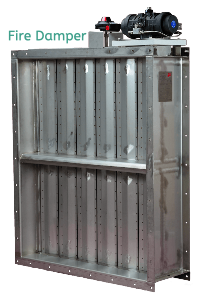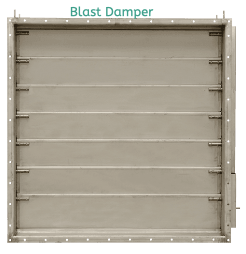Life safety dampers are critical parts of a ventilation system necessary to protect people and equipment when a disaster occurs. In normal operating conditions, these dampers allow air to flow through the ventilation system with minimal interference. However, when something catastrophic occurs, they close to prevent shock waves, smoke or heat from traveling to other parts of the structure. In this article, I’ll discuss how these life safety dampers are incorporated into ventilation systems to keep people safe.
Smoke Dampers
The leading cause of death associated with fires is from inhalation of smoke and fumes. Therefore, smoke dampers are used as part of either a passive or engineered smoke control system to prevent passage of smoke between compartments within a structure. When smoke is detected by the fire control system, a signal is sent to the smoke damper actuator to close. The key feature of smoke dampers are the specially designed blades that provide air tight seals to each other and to the damper frame. Smoke dampers are most often used in office buildings to prevent smoke passage between floors.
UL Classified smoke dampers are tested to UL Standard 555S. UL standards classify smoke dampers based on the amount of smoke leakage with Class I dampers having the lowest leakage rate. These UL Standards also assure that the smoke dampers will operate under elevated temperatures and can close against air pressures and velocities encountered when a fire event occurs.
Fire Dampers
When it is critical to prevent flames from passing between compartments of a structure through the ventilation system, a fire damper is used. Fire dampers have a fusible link that holds the damper blades open under normal conditions. When the temperature within the duct exceeds the rating of the fusible link, it melts and the damper blades close by either gravity or force from a spring. Air supply and exhaust duct work for an engine or boiler room are good examples of where fire dampers are commonly used.
The type of fire damper selected for an application is based on a number of options:
- Fire Resistance:
- 1.5 or 3 hour ratings are available
- Damper rating is usually 75% of the partition rating
- Airflow Closure:
- Static fire dampers – designed to close only when the ventilation system is set to shut off in the event of a fire
- Dynamic fire dampers – designed to close with the ventilation system running and have an airflow velocity and pressure rating
- Fusible link set point:
- Set point options start at 165 F
- Vertical or horizontal mounting orientation:
- Vertically mounted fire dampers or fire curtains can be gravity or spring close
- Horizontally mounted fire dampers must be spring close
Combination Fire/Smoke Dampers
A combination fire/smoke damper is used when structure compartments are separated by dual purpose fire and smoke barriers. A combination fire/smoke damper must seal tight to prevent smoke leakage and have 1.5 or 3 hour fire rating. It also must be able to close other by detection of heat or smoke. Combination dampers use resettable electric release devices instead of a fusible link for closing in the event of a fire.
 Blast Dampers
Blast Dampers
The most catastrophic event that can occur inside or outside of a structure is an explosion. Blast dampers are used to prevent the transmission of shock waves through the ventilation system of a structure. Because shock waves travel extremely fast, a blast damper must also react quickly. The blades of a blast damper are held open by a spring and when pressure from an explosion overcomes the resistance of the spring, the damper blades close. It is important that once the blades close, they must stay closed to resist the backdraft that follows an explosion. Many petrochemical companies have onsite control rooms that are protected from external explosions with blast dampers.
Flamgard Calidair
Eldridge is proud to represent Flamgard Calidair life safety dampers in North America. They have a worldwide reputation for providing the highest quality products that meet or exceed all of the international standards for life safety dampers. Based on their reputation for building quality products when protecting people is the ultimate goal, Flamgard Calidair was selected to provide the nuclear grade dampers for the Chernobyl New Safe Confinement structure.
Eldridge uses Flamgard Calidair life safety dampers on a wide range of projects for nuclear power plants and mobile offshore drilling units. If your new design or retro fit project requires protecting people and equipment in the event of a disaster, let us help you select the right Flamgard Calidair life safety damper to fit your application.
